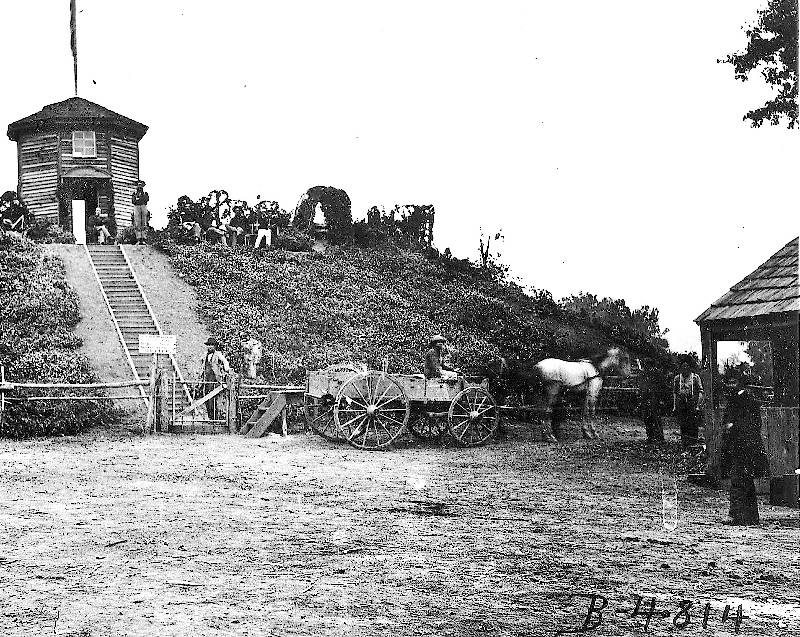
 | saved from timesfreepress.com/news/opinion/columns/story/2015/mar/01/whatever-happened-citico-mound/290447/ |
Honerkamp: Whatever happened to Citico Mound?
"Out of sight, out of mind." The truth of this adage is never better demonstrated than with the story of the prehistoric Citico Mound.
 |
http://media-cdn.timesfreepress.com/img/photos/2015/02/26/...historycitico....jpg
Citico Mound in 1864, complete with staircase, "Out of sight, out of mind." The truth of this adage is never better demonstrated than with the story of the prehistoric Citico Mound. Located at the junction of Citico Creek and the Tennessee River, near where the Boathouse restaurant now stands, the Citico site was at one time a large village and ceremonial center containing a huge earthen mound. Measuring at least 160 by 120 feet and 20 feet high, the flat-top mound served as a platform for the home of a powerful chief several centuries ago. Fronting the mound was a large village plaza, surrounded by dozens of "wattle and daub" houses (made from a framework of posts and tree branches covered with clay). The village landscape included burials around and sometimes in the houses. At the opposite end of the plaza was a small flat-top mound containing burials and possibly house foundations of a lesser chief. The entire complex -- mounds, plaza, burials and village -- was probably surrounded by a sturdy defensive palisade made of upright logs. Such protective palisades have been found at other significant sites, including Moccasin Bend. |
According to Dr. James Hatch, a Pennsylvania State University archaeologist who gathered information on what was found at the site in more than a century of sporadic excavations, the heyday of Citico was during the 14th century. However, by the time Spanish soldiers associated with the de Luna expedition paid a brief visit to this area two centuries later [1560], the site was largely abandoned. In the 19th century, after Chattanooga was established, the mound was a prominent landmark that caught the attention of occupying Union soldiers [1864, photo] and a succession of relic collectors.
How could such a substantial and interesting prehistoric monument vanish from view and our collective memory? Much of the mound literally disappeared in 1915, when it was used as fill dirt during the construction of the Dixie Highway, aka Riverside Drive. Just prior to its destruction, the site was excavated on two occasions by Clarence B. Moore, affiliated with the Academy of Natural Sciences in Philadelphia. Moore was disappointed that his crew discovered no burials while digging their 12-by-12-foot square hole into the main mound. He attributed this to competition with local collectors. Eventually, however, Moore did discover 106 burials and an abundance of artifacts in other areas of the site, including the small mound. He produced a detailed report on his findings, and his Aboriginal Sites on the Tennessee River (1915) can be found today in the Chattanooga Public Library. In 1957, the last remaining remnants of the mound were destroyed during the widening of Riverside Drive to four lanes.
Using Moore's findings, Hatch concluded in 1976 [1976 The Citico Site (40HA65): A Synthesis. Tennessee Anthropologist] that Citico ranked "at or near the top" in mortuary complexity and as an expression of chiefly power was "the most impressive and perhaps the dominant site" in the area for its time. A review of Citico artifacts and excavation records, along with recent information on the dating and composition of other major mound sites in the region including Hixson, Dallas, Hiwassee Island and Etowah, has allowed a revision of Hatch's interpretation. Dr. Lynne Sullivan of the McClung Museum at University of Tennessee at Knoxville [Reconfiguring the Chickamauga Basin 2011] has been able to use radiocarbon dates, mound construction data and new information on changes in architecture over time -- information that was largely unavailable to Hatch. She determined that the big mound was constructed at least two centuries before the smaller mound. In Sullivan's own words:
"We can now see that the spatial differentiation in mortuary practices [Hatch] observed among the large mound, village midden and smaller mound reflect temporal changes, not status differentiation."
Sullivan was able to better place Citico in a regional perspective. Her research underscores how Native American settlements in southeastern Tennessee were dynamic and complex, changing through time. Rather than the home of a politically "dominant" chief in our river valley, Citico actually was similar to other local sites, including the Hixson, Dallas, and Hiwassee Island sites. Future research will likely refine our understanding even further.
The "Citico saga" is instructive on more than one level. It's a sad reminder that there are sometimes substantial costs to modernization and development. And it shows that research on our collective heritage is not a static exercise but rather one that actively changes as new discoveries are brought to light.
Dr. Nicholas Honerkamp is an archaeologist at the University of Tennessee at Chattanooga. For more, visit chattahistoricalassoc.org or call LaVonne Jolley 423-886-2090.